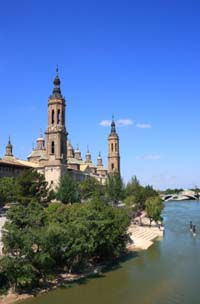Zaragoza Aragon
Useful Zaragoza map, and guide to the city in Aragon, Spain.
Zaragoza Map and City Guide
Zaragoza Map: Above you can view an interactive map of Zaragoza, the capital of and largest city in the Aragon region of Spain. Clearly shown on this Zaragoza map are the River Ebro, which flows through the city, the Parque del Libro de la Silva, and the surrounding areas of Cuarte de Huerva, Utebo, Monzalbarba, Juslibol, San Gregorio and Montañana.
Zaragoza: Housing over 50% of the population of the Aragon region in northern Spain, Zaragoza (Saragossa) pre-dates even the Roman occupation of the region. The city lies on both sides of the River Ebro and is the capital of a province of the same name. Now the fifth largest city in Spain, Zaragoza has a population of over 700,000 and is a mostly industrial city, but with a strong historical and cultural heritage, it was the location of the Expo 2008 World Fair.
 Zaragoza History: Site of an ancient Celtiberian settlement called Salduba, Zaragoza later became the Roman city of Caesaraugusta, founded as such in around 25BC (well preserved remains of a Roman theatre can still be seen in the city). Following the decline of the Roman Empire, Zragoza was taken first by the Gauls in the 5th century AD, and then by the Moors in the early eighth century (714 AD). Under the Moors, it quickly developed into the largest Arab controlled city in northern Spain, attracting the attention of Charlemagne, who tried to take the city in 777 AD, but was repelled by strong defences and additional attacks in the rear by Basques under Chanson de Roland.
Zaragoza History: Site of an ancient Celtiberian settlement called Salduba, Zaragoza later became the Roman city of Caesaraugusta, founded as such in around 25BC (well preserved remains of a Roman theatre can still be seen in the city). Following the decline of the Roman Empire, Zragoza was taken first by the Gauls in the 5th century AD, and then by the Moors in the early eighth century (714 AD). Under the Moors, it quickly developed into the largest Arab controlled city in northern Spain, attracting the attention of Charlemagne, who tried to take the city in 777 AD, but was repelled by strong defences and additional attacks in the rear by Basques under Chanson de Roland.
During the 11th and 12th centuries Zaragoza (or Saraqusta as it was called by the Moors), became an independent Muslim state (taifa), ruled by Banu Jujiba, Banu Hud and then the Almoravids, until it was finally conquered by the Aragonese led by Alfonso I “El Batallador” (The Battler) in 1118, swiftly becoming the capital of the Kingdom of Aragon, replacing Huesca.
Zaragoza suffered badly during the Peninsular War in the early 19th century, and was besieged twice by the Napoleonic Army, finally surrendering after the loss of some 50,000 of its defenders, afterwards much of the city had to be rebuilt.
The city boomed in the 20th century, despite a general decline in the surrounding rural areas, and the population rose from around 100,000 in 1900 to over 600,000 by the end of the century.
Zaragoza Attractions: There are plenty of attractions to visit whilst in Zaragoza, the main one being the Basilica de Nuestra Señora del Pilar, a massive church standing in the Plaza del Pilar, beside the River Ebro, its colourfully tiled cupolas can be seen from various vantage points across the city. Other important sights include the cathedral of San Salvador (originally 11th century), known as “La Seo”, the Santa Maria Magdalena church, the churches of San Pablo, San Miguel and San Gil Abad, the Museo de Zaragoza, the Museo Camón Aznar, and the Museo Pablo Gargallo, the Roman wall, theatre and ruins, and the 11th century Moorish palace, the Aljafería.
Zaragoza Weather/Climate: Experiencing a semi-arid climate, Zaragoza’s weather is influenced by its position in a river basin, surrounded by mountains. It sees hot, dry summers, mild, wet springs and autumns, and cold, dry winters, the average annual rainfall is just 310mm. Summer high temperatures can reach 40°C, winter lows can drop to freezing.
Aragon Information: Aragon Map and Guide
More Aragon Places: Tarazona - Catalayud - Alcaniz - Teruel - Alcala de la Selva - Valdelinares - Candanchu - Daroca
Related: Andalucia - Catalonia - Galicia - Madrid - Valencia - Castilla-La Mancha - Builders
HOME
